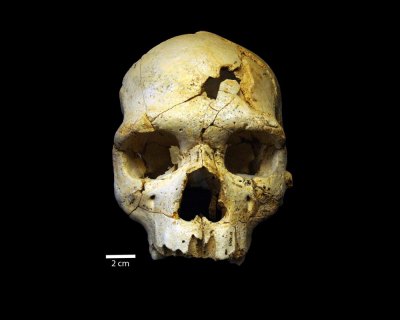In Brief: Murder among the ruins

A skeleton found in the Sima de los Huesos (pit of bones), an archeological site in the Atapuerca Mountains of northern Spain, is the earliest clear case of murder "in the hominin fossil record, demonstrating that this is an ancient human behavior,” scientists say in a study published May 27, “Lethal Interpersonal Violence in the Middle Pleistocene."
The cranium of one skeleton shows two “fractures on the frontal bone, interpreted as being produced by two episodes of localized blunt force trauma,” researchers concluded in the publication PLOS-One, the Public Library of Science’s peer reviewed journal. The closeness of the fractures suggests "they were produced with the same object in face-to-face interpersonal conflict. Given that either of the two traumatic events was likely lethal, the presence of multiple blows implies an intention to kill.”
Scientists explain that understanding violence among hominids “provides a window into human social relations in the past and may be associated with subsistence contexts such as competition for scarce resources, population density or territorial defense.”
All in the family: Researchers have found yet another branch of the human family tree.
A new species was discovered about 22 miles (35 kilometers) from the site where scientists uncovered “Lucy,” the skeleton found in 1974 in northern Ethiopia.
There were at "least two contemporaneous hominin species living in the Afar region of Ethiopia between 3.3 and 3.5 million years ago," according to the article, New Species from Ethiopia Further Expands Middle Pliocene Hominin Diversity.
In a statement, the study’s lead author, Yohannes Haile-Selassie, curator of physical anthropology at the Cleveland Museum of Natural History, said the new species is “yet another confirmation that Lucy's species, Australopithecus afarensis, was not the only potential human ancestor species that roamed in what is now the Afar region of Ethiopia during the middle Pliocene."
Related:
Newly identified dinosaur: A chicken from hell
If you would like to comment, contact StudyHall.Rocks or like us on Facebook and tell us what you think.

